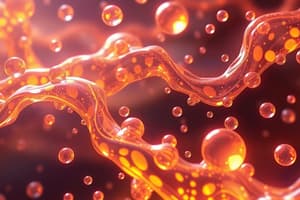Podcast
Questions and Answers
What effect does the presence of double bonds have on the melting point of fatty acids?
What effect does the presence of double bonds have on the melting point of fatty acids?
- Increases the melting point
- Causes the fatty acid to solidify completely
- Has no effect on the melting point
- Lowers the melting point (correct)
Which type of fatty acid has no C-C double bonds?
Which type of fatty acid has no C-C double bonds?
- Trans Fatty Acids
- Unsaturated Fatty Acids
- Saturated Fatty Acids (correct)
- Polyunsaturated Fatty Acids
What property of unsaturated fatty acids makes them important in the film industry?
What property of unsaturated fatty acids makes them important in the film industry?
- High melting point
- Ability to form hard films (correct)
- Low viscosity
- Low reactivity
Which type of fatty acid tends to be liquid at physiological temperature if containing less than eight carbon atoms?
Which type of fatty acid tends to be liquid at physiological temperature if containing less than eight carbon atoms?
Which of the following is an example of a saturated fatty acid?
Which of the following is an example of a saturated fatty acid?
What is the process by which double bonds in unsaturated fatty acids take up hydrogen to produce semi-solid fats?
What is the process by which double bonds in unsaturated fatty acids take up hydrogen to produce semi-solid fats?
Which method of extraction is used to obtain Virgin/Cold Pressed Oil?
Which method of extraction is used to obtain Virgin/Cold Pressed Oil?
Which of the following oils is classified as a saturated fixed oil?
Which of the following oils is classified as a saturated fixed oil?
Among the options, which is an example of a polyunsaturated fixed oil?
Among the options, which is an example of a polyunsaturated fixed oil?
Which of the following is an example of a fat or related compound?
Which of the following is an example of a fat or related compound?
Which of these is an example of a solid vegetable oil?
Which of these is an example of a solid vegetable oil?
What are waxes primarily composed of?
What are waxes primarily composed of?
What is the primary function of fixed oils and fats obtained from plants and animals?
What is the primary function of fixed oils and fats obtained from plants and animals?
Which of the following is a chief difference between fixed oils/fats and waxes?
Which of the following is a chief difference between fixed oils/fats and waxes?
According to USP tests for fatty acids, what is a characteristic test for unsaturation?
According to USP tests for fatty acids, what is a characteristic test for unsaturation?
Which of the following is an example of a fixed oil obtained from a plant source?
Which of the following is an example of a fixed oil obtained from a plant source?
In the classification of fixed oils and fats, what type of alcohol combines with fatty acids?
In the classification of fixed oils and fats, what type of alcohol combines with fatty acids?
Which of the following is an example of a wax due to its high molecular weight alcohol content?
Which of the following is an example of a wax due to its high molecular weight alcohol content?
Flashcards are hidden until you start studying
Study Notes
Waxes
- Beeswax: CH3(CH2)14CO2-(CH2)15CH3
- Carnauba wax: CH3(CH2)24CO2-(CH2)29CH3
- Spermaceti: CH3(CH2)30CO2-(CH2)33CH3
- Uses: hardens ointments and creams, preparation of cerates, protective coatings in industry and art
Sources of Waxes
- Plants: Carnauba wax, Bayberry wax
- Insects: Beeswax, Lacwax
- Other Animals: Spermaceti
Fatty Acids
- Saturated Fatty Acids: no C-C double bonds
- Unsaturated Fatty Acids: with double bonds
- Lauric acid, myristic acid, palmitic acid, stearic acid, arachidic acid
Fixed Oils and Fats
- Vegetable Oils: mostly liquid at ordinary temperature, except cocoa butter
- Animal Fats: mostly solid, except cod liver oil
- Obtained by expression in hydraulic presses: cold or hot pressed, sometimes with organic solvents
- Classification: saturated, monounsaturated, polyunsaturated
Classification of Fixed Oils and Fats
Saturated
- Coconut Oil
- Palm Oil
- Palm Kernel Oil
Monounsaturated
- Castor Oil
- Olive Oil
- Peanut Oil
- Rapeseed Oil
Polyunsaturated
- Almond Oil
- Corn Oil
- Cottonseed Oil
- Cod Liver Oil
- Linseed Oil
- Persic Oil
- Soybean Oil
- Sesame Oil
- Safflower Oil
- Sunflower Oil
Fats and Related Compounds
- Theobroma Oil (Cacao Butter/Cocoa Butter)
- Lanolin (Hydrous Woolfat)
- Anhydrous Lanolin (Woolfat)
- Hydrogenated Vegetable Oils
- Lard
Studying That Suits You
Use AI to generate personalized quizzes and flashcards to suit your learning preferences.




